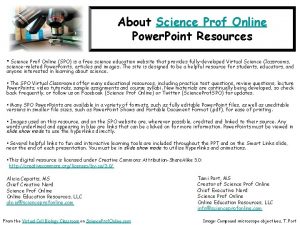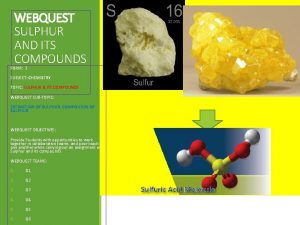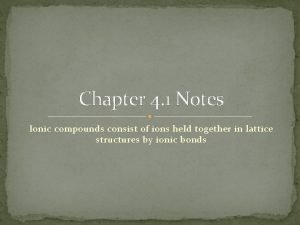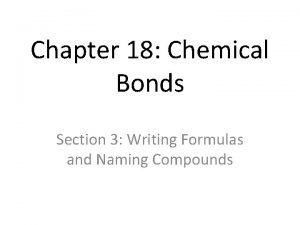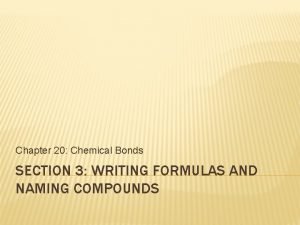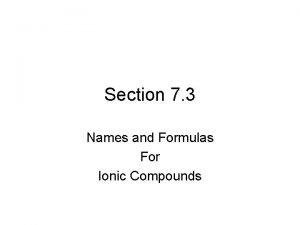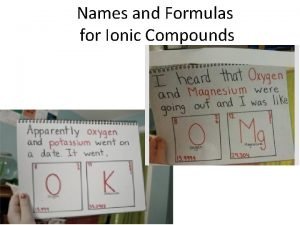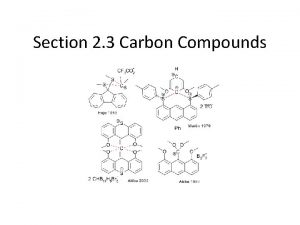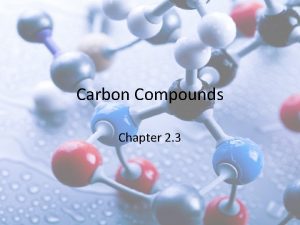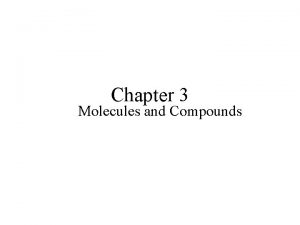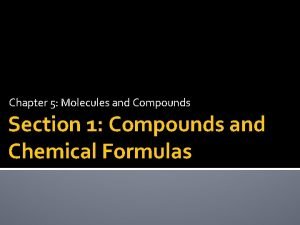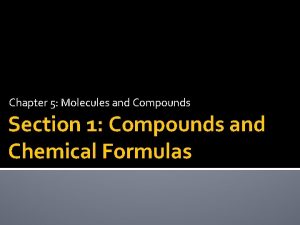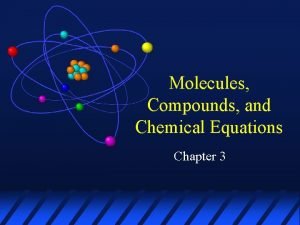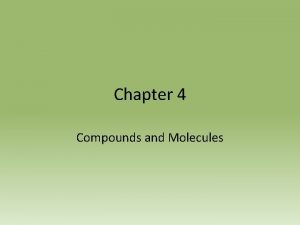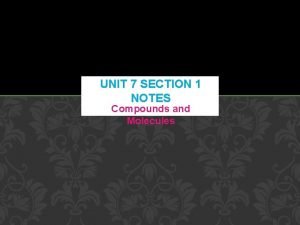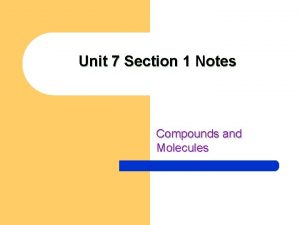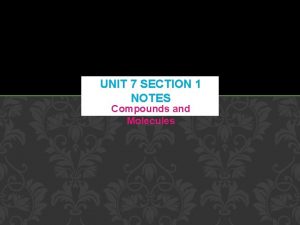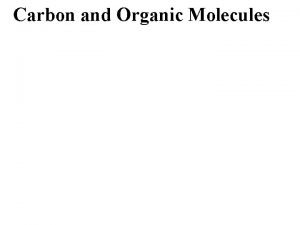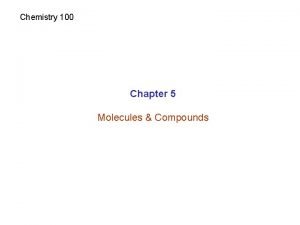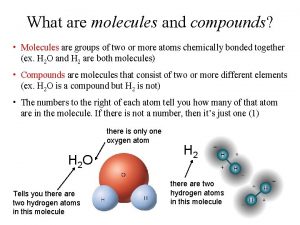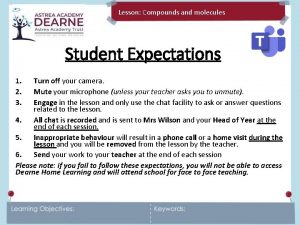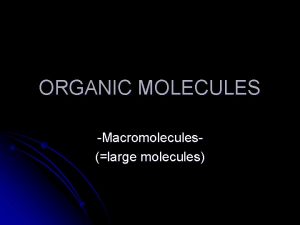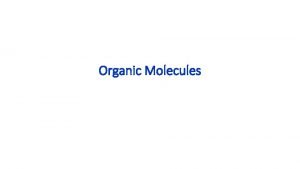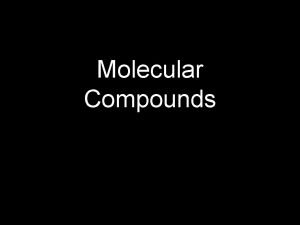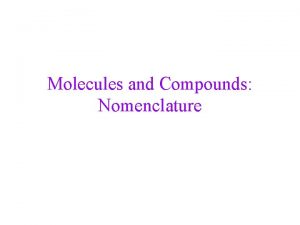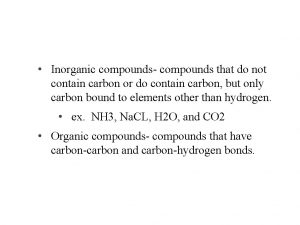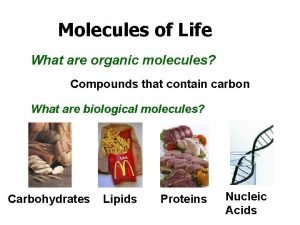Chapter 4 Section 1 Notes Compounds and Molecules






















- Slides: 22

Chapter 4 Section 1 Notes Compounds and Molecules

What are Compounds? l l A compound is made of 2 or more elements joined together. When elements combine to form a compound, the compound has very different properties than the elements that made it.

Example of a Compound l Sodium, a metal, combines with chlorine, a gas, to make table salt, a small white crystal. + →


Chemical Bonds l l The forces that hold atoms or ions together in a compound are called chemical bonds. Chemical bonds are the difference between compounds and mixtures – A compound is formed through chemical bonding.

Chemical Bonds vs. Mixtures l Mixtures are made of different substances just placed together – – Each substance in the mixture keeps its own properties Example: Mixing yellow and blue paint gives green paint, but the properties of the paint have not changed. + →

When is a compound formed? l A compound is formed when chemical bonds are broken and atoms are rearranged.

Chemical Formula l l A compound ALWAYS has the same chemical formula. A chemical formula shows the types and numbers of atoms or ions making up the simplest unit of the compound.

Examples of Chemical Formulas l l H 2 O: Water: 2 Hydrogen atoms; 1 Oxygen atom C 12 H 22 O 11: Sugar: 12 Carbon atoms; 22 Hydrogen atoms; 11 Oxygen atoms Na. Cl: Table Salt: 1 Sodium atom; 1 Chlorine atom Note: When there is no subscript, it is understood to be “ 1”.

Compounds l Compounds are ALWAYS made of the same elements in the same proportion!!!!!!!

Chemical Structure l l Chemical Structure is the way the compound’s atoms are bonded to make the compound. Just as the structure of buildings can be represented by blueprints, the structure of chemical compounds can be shown by various models. Different models show different aspects of compounds.

Ball-and-Stick Model l This model helps you see a compound’s structure by showing how the atoms or ions are arranged in a compound. – – Atoms: represented by balls Bonds: represented by sticks 104. 45˚ Ball-and-Stick model for water.

Arrangement of Compounds l Two words are used to tell how atoms or ions are positioned in a compound: – – l Bond length: the distance between the nuclei of two bonded atoms. Bond angle: the angle formed by two bonds to the same atom. The Ball-and-Stick model helps you see bond length and bond angle.

Structural Formula l l Structural formulas can also show the structures of compound In a structural formula, atoms are represented by chemical symbols. O H H

Space-Filling Models l Space-filling model shows how much space atoms take up – The different sizes of the atoms can be seen, but not bond lengths.

Bonds are Flexible l l Chemists often use a solid bar to show a bond between two atoms, but bonds are actually flexible, like springs. Atoms can actually move back and forth a little bit.

Properties of Compounds l What determines many of a compound’s properties? – – The atoms present in a compound The way the atoms are arranged (chemical structure)

Video

How Does Structure Affect Properties? l Compounds with network structures are strong solids – Quartz is made of silicon dioxide, Si. O 2 l l Every Si atom is bonded to 4 oxygen atoms; all bond angles are the same at 109. 5˚, which holds the atoms together in a strong, rigid structure The bonds that hold quartz together is very strong and takes a lot of energy to break the bonds, which is why the melting and boiling points are so high

How does Structure Affect Properties? l Some networks are made of bonded ions, which have very strong attractions between the positively and negatively charged ions – – The strong attraction requires a lot of energy to break the bonds, which is why these network structures have high melting and boiling points. Examples: table salt, Na. Cl; magnesium oxide, Mg. O

How Does Structure Affect Properties? l Some compounds are made of molecules – – A molecule of sugar is made between bonds of carbon, hydrogen, and oxygen and the attraction between the molecules is much weaker than an ionic bond. Compounds made of molecules do not have a strong attraction holding atoms together, so they have a lower melting and boiling point than compounds with ionic bonds.

Strength of Attraction Between Molecules l l The weaker the force of attraction between molecules, the easier the substance will be to break apart Molecules of gases have weak attractions to one another, so they spread out and take up a lot of space.
 Organic molecules vs inorganic molecules
Organic molecules vs inorganic molecules Study jams mixtures
Study jams mixtures All compounds are molecules
All compounds are molecules Science prof online
Science prof online Ionic covalent and metallic bonding
Ionic covalent and metallic bonding Chemistry in biology section 2 chemical reactions
Chemistry in biology section 2 chemical reactions Chapter 6 section 1 atoms elements and compounds
Chapter 6 section 1 atoms elements and compounds Sulphur and its compounds klb notes
Sulphur and its compounds klb notes Chapter 7 chapter assessment ionic compounds and metals
Chapter 7 chapter assessment ionic compounds and metals Chemistry chapter 7 ionic and metallic bonding
Chemistry chapter 7 ionic and metallic bonding Concept 2 notes naming ionic compounds
Concept 2 notes naming ionic compounds Section 3 writing formulas and naming compounds answer key
Section 3 writing formulas and naming compounds answer key Section 1 atoms elements and compounds
Section 1 atoms elements and compounds Section 3 writing formulas and naming compounds
Section 3 writing formulas and naming compounds Section 3 names and formulas for ionic compounds
Section 3 names and formulas for ionic compounds Section 3 names and formulas for ionic compounds
Section 3 names and formulas for ionic compounds Chapter 2 atoms molecules and ions
Chapter 2 atoms molecules and ions Section 2-3 carbon compounds
Section 2-3 carbon compounds Section 2-3 carbon compounds
Section 2-3 carbon compounds Chapter 3 molecules of life
Chapter 3 molecules of life Facteur g
Facteur g Empirical formula pogil
Empirical formula pogil Chapter 7 review modern chemistry answers
Chapter 7 review modern chemistry answers



